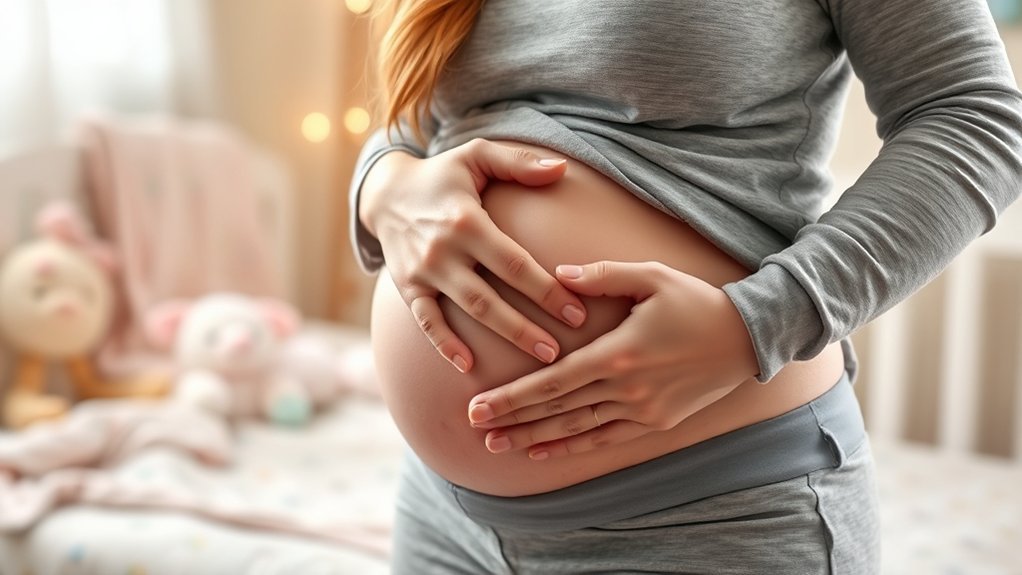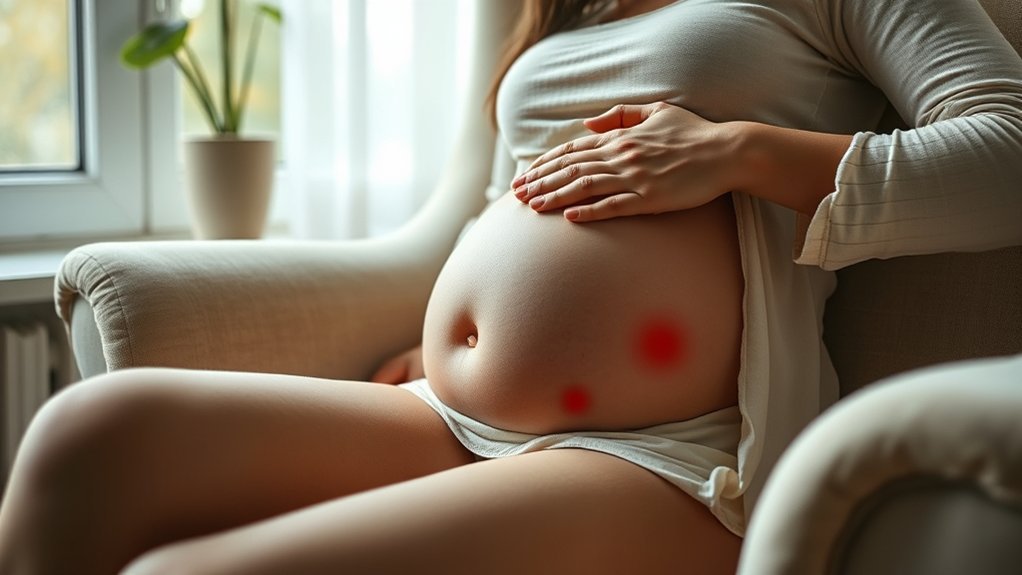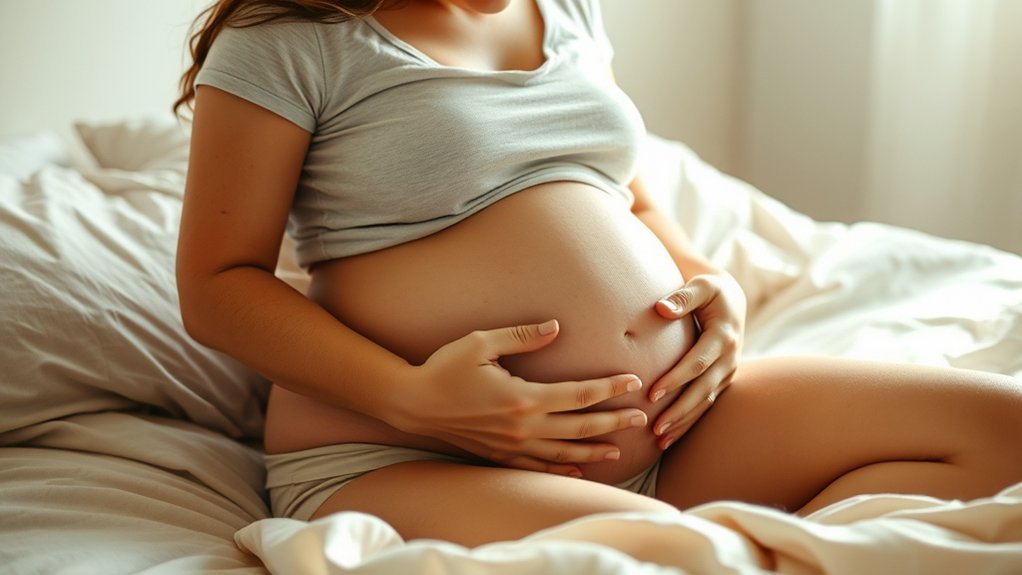Experiencing postpartum hemorrhoids can feel like a cruel twist of fate for new parents. These painful, swollen veins can disrupt your daily life and create added stress during an already challenging time. Understanding the causes and symptoms is essential for effective recovery. Are you aware of what steps you can take to manage this common condition? Let’s explore the implications of postpartum hemorrhoids and how to navigate this issue effectively.
Understanding Hemorrhoids

Hemorrhoids are a common concern for many postpartum women, affecting about 25% of new moms. These swollen veins can occur in the lower rectum and anus, leading to symptoms like pain, itching, and rectal bleeding.
Hemorrhoids affect about 25% of postpartum women, causing pain, itching, and rectal bleeding in the lower rectum and anus.
You might experience internal hemorrhoids, which are inside the rectum, or external ones that protrude outside the anus. Postpartum hormonal changes, increased pressure from the uterus, and straining during labor can contribute to the development of hemorrhoids.
Additionally, constipation, often exacerbated by pain medication and stress, can worsen symptoms. It’s vital to recognize signs like bright red blood during bowel movements and pressure around the anus.
Understanding these symptoms can guide you toward treatment options and effective prevention strategies.
Causes of Postpartum Hemorrhoids
Postpartum hemorrhoids often stem from hormonal changes and the physical strain of labor.
Elevated progesterone levels can relax blood vessel walls, increasing the likelihood of swelling.
Additionally, the pressure from straining during delivery can worsen the condition, making it essential to understand these contributing factors.
Hormonal Changes Impact
As your body undergoes significant hormonal changes during and after pregnancy, the likelihood of developing hemorrhoids increases. Elevated progesterone levels relax blood vessel walls, causing swelling and making you more susceptible to hemorrhoids. This hormone also slows bowel movements, leading to constipation, which can further exacerbate the issue.
Consider these factors:
- Hormonal fluctuations persist postpartum, affecting bowel function.
- Increased blood volume and fluid retention elevate pressure on pelvic veins.
- Approximately 40% of women face hemorrhoids during pregnancy and postpartum.
Understanding these hormonal changes can help you manage symptoms and seek appropriate care.
Labor Strain Effects
During labor, the intense physical strain of pushing can greatly increase pressure on your pelvic veins, which may lead to the development of hemorrhoids after delivery. Approximately 40% of women face this issue, often exacerbated by straining during the pushing phase. Elevated progesterone levels during pregnancy relax vein walls, making them more susceptible to swelling. The expanding uterus and baby weight hinder blood return, increasing the risk of hemorrhoid formation. If you’ve had hemorrhoids before or have a family history, your risk is even higher.
| Factor | Description | Emotional Impact |
|---|---|---|
| Physical Strain | Increased pressure on pelvic veins | Pain and discomfort |
| Hormonal Changes | Elevated progesterone leads to vein relaxation | Frustration |
| Delivery Process | Straining can worsen symptoms | Anxiety about recovery |
| Constipation | Common postpartum issue that exacerbates hemorrhoids | Discomfort and stress |
| History of Hemorrhoids | Prior issues increase risk post-delivery | Worry about recurrence |
Symptoms of Postpartum Hemorrhoids
After giving birth, you might experience several symptoms related to hemorrhoids.
Common issues include pain, itching, and bright red bleeding during bowel movements.
Understanding the differences between internal and external hemorrhoids can help you recognize when it’s time to seek medical advice.
Common Symptoms Experienced
Postpartum hemorrhoids can lead to a range of distressing symptoms that many new parents experience.
You might notice various signs that indicate swollen veins in the anal area, including:
- Bright red bleeding during bowel movements, often signaling irritation or damage.
- Pain and discomfort, particularly after bowel movements, which can disrupt your daily activities.
- Itching and burning sensations caused by inflammation and irritation of the hemorrhoidal tissue.
Additionally, you may find sensitive lumps or protruding veins near your anus.
These symptoms of postpartum hemorrhoids affect around 43% of women, highlighting how common this condition is among new parents.
Understanding these symptoms is essential for managing your comfort and seeking appropriate care.
Internal vs. External Hemorrhoids
Understanding the type of hemorrhoids you might experience can help in managing symptoms effectively. Internal hemorrhoids develop inside the rectum and may not be visible, but they can cause pain, pressure, and bleeding during bowel movements. In contrast, external hemorrhoids form around the anal opening, presenting as sensitive lumps that lead to itching, pain, and possible bleeding. Both types result from increased pressure on the pelvic veins due to pregnancy, labor, and postpartum constipation.
| Type | Symptoms | Location |
|---|---|---|
| Internal Hemorrhoids | Bright red bleeding, pain | Inside the rectum |
| External Hemorrhoids | Visible swelling, itching, discomfort | Around the anal opening |
| Both Types | Pressure on the veins, constipation | Affects pelvic veins |
When to Seek Help
When should you seek help for postpartum hemorrhoids?
It’s essential to monitor your symptoms closely and consult a doctor if you experience any of the following:
- Bright red bleeding during bowel movements that persists or increases
- Persistent pain or discomfort in the anal area that doesn’t improve with home treatments
- Hard, swollen hemorrhoids, especially if accompanied by intense itching
Ignoring these signs may lead to complications.
Long episodes of rectal bleeding that exceed a small amount require immediate medical attention to rule out serious issues.
Additionally, a purple, enlarged vein around the anus may suggest a clot, necessitating prompt intervention.
Always prioritize your health and don’t hesitate to seek professional guidance.
Management and Recovery Strategies
Managing and recovering from hemorrhoids after childbirth involves several effective strategies that can greatly ease discomfort.
Start by maintaining a high-fiber diet rich in fruits, vegetables, and whole grains to prevent constipation, which is vital for managing postpartum hemorrhoids.
Stay hydrated by drinking at least eight cups of water daily, especially if you’re breastfeeding, to guarantee softer stools.
Engaging in light exercise, like short walks, can further promote healthy bowel function.
To find soothing relief, soak in a sitz bath for about 15 minutes several times a day to help shrink swollen hemorrhoids.
Additionally, applying an ice pack wrapped in cloth to the affected area for 15 to 30 minutes can alleviate symptoms and reduce swelling. It’s also important to consider reaching out for support from information specialists who can provide guidance on managing postpartum health concerns effectively.
When to Seek Medical Advice

Are you unsure about when to seek medical advice for hemorrhoids after childbirth? It’s vital to monitor your symptoms closely.
Consider reaching out to your healthcare provider if you experience:
- Persistent pain or significant discomfort that doesn’t improve with home treatment
- Significant rectal bleeding, especially if it’s more than a small amount
- Hard, painful hemorrhoids, which could indicate thrombosis
Additionally, if your symptoms are accompanied by fever or severe abdominal pain, don’t hesitate to consult a doctor. These could signal serious complications.
Regular postpartum checkups are also important, as they help monitor your overall health and any issues related to hemorrhoids. Being proactive can prevent further complications and guarantee your recovery remains on track. Remember, UNICEF emphasizes the importance of children’s health and nutrition programs, which can be relevant for parents navigating postpartum challenges.
Key Takeaway
Recognizing the prevalence and impact of postpartum hemorrhoids is essential for new mothers. Approximately 40% of women experience hemorrhoids following childbirth, often due to increased abdominal pressure and hormonal changes.
Symptoms like pain, itching, and bleeding can affect your emotional well-being, making it important to address them. A high-fiber diet and proper hydration are key to preventing constipation and easing bowel movements.
Addressing symptoms like pain and itching is vital for emotional well-being; focus on a high-fiber diet and hydration for relief.
Implementing self-care strategies, such as sitz baths and ice packs, can provide significant pain relief. If symptoms persist or worsen, don’t hesitate to consult your healthcare provider.
Prioritizing both physical and mental health during your postpartum recovery is essential for overall wellness and a smoother shift into motherhood. Additionally, understanding the importance of community involvement in maternal health can provide support and resources for new mothers facing these challenges.
Frequently Asked Questions
How Long Does It Take Postpartum Hemorrhoids to Go Away?
Postpartum hemorrhoids usually improve within days to weeks. You can enhance recovery by staying hydrated, making dietary changes, and using home treatments. If symptoms persist beyond two weeks, consult a healthcare professional for advice.
How to Deal With Hemorrhoids After Giving Birth?
To deal with hemorrhoids after giving birth, increase your fiber intake, stay hydrated, and respond promptly to bathroom urges. Sitz baths, ice packs, and over-the-counter treatments can relieve symptoms, but consult your healthcare provider for persistent issues.
What Can I Use for Hemorrhoids While Breastfeeding?
Like a gardener nurturing delicate blooms, you can soothe your discomfort with witch hazel pads, safe creams, or sitz baths. Staying hydrated and eating fiber-rich foods can help you flourish while breastfeeding.
How to Shrink Hemorrhoids Quickly?
To shrink hemorrhoids quickly, try warm sitz baths several times daily, apply ice packs for inflammation, use over-the-counter creams, and maintain a high-fiber diet while staying hydrated to promote healing and reduce discomfort.
Conclusion
In summary, if you’re among the 25% of new mothers dealing with postpartum hemorrhoids, know you’re not alone. These swollen veins can cause discomfort, but with proper self-care—like a high-fiber diet and hydration—you can ease symptoms. Remember, prioritizing your well-being is essential during this changeable period. If you’re ever in doubt or your symptoms worsen, don’t hesitate to seek medical advice. Your health matters, and recovery is possible with the right support.
